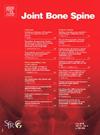轴型脊柱炎中运动恐惧症的患病率和与患者报告的结果和活动度测量的关联。
IF 3.8
3区 医学
Q1 RHEUMATOLOGY
引用次数: 0
摘要
目的:探讨axSpA患者运动恐惧症的患病率及其与健康、疾病活动度、功能、脊柱活动度和身体活动的关系。方法:采用坦帕运动恐惧症量表(TSK)和恐惧回避信念问卷(FABQ)对连续的axSpA患者(n=100)和20名健康对照(HC)进行横断面观察性研究。收集患者报告的结果和疾病活动、身体功能、整体健康和功能的客观评估,以及BASMI、as身体性能指数(ASPI)、短身体性能电池(SPPB)和Epionics SPINE (ES)测量,包括活动范围(RoM)和运动学(RoK)。结果:axspa患者TSK评分(25.5±6.8 vs 14.0±5.1)和FABQ评分(40.1±22)均高于axspa患者。(3.1±6.9))与HC比较,p均≤0.001。对运动恐惧症水平的分类分析显示,运动恐惧症水平较高的患者在ASPI和SPPB任务中的表现明显较差,并且在BASMI和ES测量中也表现出损伤。TSK和FABQ评分与ASAS HI (r=0.45和r=0.52)和BASFI (r=0.38和r=0.44)相关,而与ASPI、SPPB和RoK无关。BASMI (r=0.24和r=0.38)和BASDAI (r均为0.35)呈弱相关。结论:运动恐惧症似乎是axspa患者的一个临床相关问题,因为在本研究中,TSK和FABQ评分中高的患者的活动能力受损更严重。有趣的是,运动恐惧症水平与身体功能、整体功能和健康的相关性比与活动能力和PA的相关性更强。本文章由计算机程序翻译,如有差异,请以英文原文为准。
Prevalence and associations of kinesiophobia with patient reported outcomes and mobility measures in axial spondyloarthritis
Objective
To investigate prevalence and associations of kinesiophobia on patients with axSpA, and its relation to global functioning and health, disease activity, function, spinal mobility and physical activity in comparison to healthy controls (HC).
Methods
Cross-sectional, observational study in which consecutive axSpA patients with axSpA (n = 100) and 20 healthy controls (HC) were examined by the Tampa scale of kinesiophobia (TSK), and the Fear avoidance belief questionnaire (FABQ). Patient reported outcomes and objective assessments of disease activity physical function, global health and functioning as well as the BASMI, the AS physical performance index (ASPI), the Short Physical Performance Battery (SPPB) and Epionics SPINE (ES) measurements, including range of motion (RoM) and kinematics (RoK) were collected.
Results
AxSpA patients showed higher TSK (25.5 ± 6.8 vs. 14.0 ± 5.1) and FABQ scores (40.1 ± 22 vs. 3.1 ± 6.9) compared to HC, all P ≤ 0.001. Categorical analyses of kinesiophobia levels revealed that patients with higher levels performed significantly worse in ASPI and SPPB tasks, and they also showed impairments in BASMI and ES measures. TSK and FABQ scores correlated with ASAS HI (r = 0.45 and r = 0.52) and BASFI (r = 0.38 and r = 0.44), but not with ASPI, SPPB and RoK. Weak correlations were found for BASMI (r = 0.24 and r = 0.38) and BASDAI (both r = 0.35).
Conclusion
Kinesiophobia seems to be a clinically relevant problem of axSpA patients, since the mobility of patients with moderate to high TSK and FABQ scores was much more impaired in this study. Of interest, the level of kinesiophobia showed stronger correlations with physical function, global functioning and health than with mobility and PA.
求助全文
通过发布文献求助,成功后即可免费获取论文全文。
去求助
来源期刊

Joint Bone Spine
医学-风湿病学
CiteScore
4.50
自引率
11.90%
发文量
184
审稿时长
25 days
期刊介绍:
Bimonthly e-only international journal, Joint Bone Spine publishes in English original research articles and all the latest advances that deal with disorders affecting the joints, bones, and spine and, more generally, the entire field of rheumatology.
All submitted manuscripts to the journal are subjected to rigorous peer review by international experts: under no circumstances does the journal guarantee publication before the editorial board makes its final decision. (Surgical techniques and work focusing specifically on orthopedic surgery are not within the scope of the journal.)Joint Bone Spine is indexed in the main international databases and is accessible worldwide through the ScienceDirect and ClinicalKey platforms.
 求助内容:
求助内容: 应助结果提醒方式:
应助结果提醒方式:


